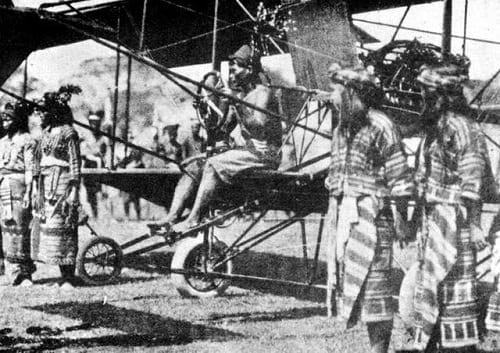The Incredible True Story of The First Filipino Airplane Passenger

The early 20th century was a monumental period in aviation history. It saw several milestones and tragedies: from the first airplane flight made by Wright brothers in 1903 to the first airplane passenger death five years later.
It was during the same era when some of the world’s earliest aircraft flew their way into America’s new colony–the Philippines. A year after the Shriver’s Skylark became the first airplane to fly over the country, the colonial government envisioned another landmark event that would soon be included in the annals of Philippine aviation.

In February 1912, to cap off that year’s Manila Carnival celebrations, Gov. Walter F. Hare brought to the city a group of 120 tribesmen all the way from their humble abode in the Mountain Province. Hare, who was in charge of the Philippine tribes, arranged the trip supposedly to give the indigenous people “a closer look at the huge bird that they had seen soaring with a man.”
Also Read: The Haunting Story of Filipinos Locked in a ‘Human Zoo’
However, news reports published later on revealed Hare’s true intentions: he wanted “to impress upon the savage tribes the absolute supremacy of the Americans.” For him to accomplish this goal, however, he needed the help of the aviator Lee Hammond.

The American pilot was in Manila to perform a series of flying exhibitions. He had been flying in the carnival for nine days when Hare convinced him to let one of the tribesmen join him in a flight.
The lucky one turned out to be Gagaban, an Igorot chief. On February 12, 1912, the brave Filipino accepted Hammond’s invitation to fly with him. Before Gagaban, no other native had ever flown as a passenger.
The aircraft that would carry out the historic flight was a “Red Devil” biplane designed by pioneer balloonist Thomas Scott Baldwin. Of course, a milestone such as this wouldn’t be complete without the much-needed photo op. An American photographer immortalized the Igorot chief by capturing a photo of him while sitting at the controls.

Other tribesmen were also delighted to pose at the camera. With the pilot and the passenger already seated on the plane, the tribesmen raised their weapons and acted as “if in pursuit of the plane carrying away their chief.”
According to accounts, Hammond and Gagaban “sat on the open in the forward edge of the lower wing, the engine facing backwards behind them.” The whole Igorot tribe probably felt uneasy as they witnessed how the American aviator took their chief on a “fast ride across the exhibition grounds” and up to 1,500 feet.
Related Article: The Short And Tragic Life of The First Igorota Beauty Queen
At that point, Gagaban officially became the first Filipino to fly as a passenger. Take note that it would only be years later, in 1920, that a Filipino pilot named Alfredo Carmelo was able to fly solo for the first time.
No one bothered to describe what Gagaban felt before and during the flight, but based on the usual emotions felt by first-time flyers, we can only imagine how scared and amazed he was. After all, he was riding an aircraft that was no better than the wobbly version flown by the Wright brothers in 1903.

Overall, the flight was a complete success. The plane landed safely and Gagaban, obviously thrilled by this once-in-a-lifetime experience, presented Hammond with his shield and battle axe as a “token of appreciation.”
The American aviator was equally pleased; he reportedly told the Times before leaving the country that “the ways of the people (i.e. Filipinos) are all American ways, their customs are American customs and above all, their hospitality is purely American hospitality.”
READ: 8 Dark Chapters of Filipino-American History We Rarely Talk About
Although considered a notable event, the news about Gagaban’s flight was not well-received by all Filipinos. In particular, they criticized how American newspapers portrayed the Igorots (described as either “wild men” or “head hunters”) as representatives of typical Filipinos in the colony.
Indeed, there’s more to Gagaban’s story than meets the eye.
References
Manila Standard,. (1987). The first Filipino to fly, p. 10. Retrieved from https://goo.gl/UcieRm
Paur, J. (2010). Sept. 17, 1908: First Airplane Passenger. WIRED. Retrieved 18 August 2015, from http://goo.gl/JlIVA4
Santos, E. (1981). Trails in Philippine Skies: A History of Aviation in the Philippines from 1909 to 1941(pp. 22, 150). Philippine Airlines.
The Evening Standard,. (1912). Wild Man In The Air. Retrieved from http://goo.gl/efOagz
The Kahimyang Project,. (2013). Today in Philippine History, July 8, 1896, Alfredo Carmelo was born in Manila. Retrieved 18 August 2015, from http://goo.gl/L2AxKL
Written by FilipiKnow
FilipiKnow
FilipiKnow strives to ensure each article published on this website is as accurate and reliable as possible. We invite you, our reader, to take part in our mission to provide free, high-quality information for every Juan. If you think this article needs improvement, or if you have suggestions on how we can better achieve our goals, let us know by sending a message to admin at filipiknow dot net
Copyright Notice
All materials contained on this site are protected by the Republic of the Philippines copyright law and may not be reproduced, distributed, transmitted, displayed, published, or broadcast without the prior written permission of filipiknow.net or in the case of third party materials, the owner of that content. You may not alter or remove any trademark, copyright, or other notice from copies of the content. Be warned that we have already reported and helped terminate several websites and YouTube channels for blatantly stealing our content. If you wish to use filipiknow.net content for commercial purposes, such as for content syndication, etc., please contact us at legal(at)filipiknow(dot)net